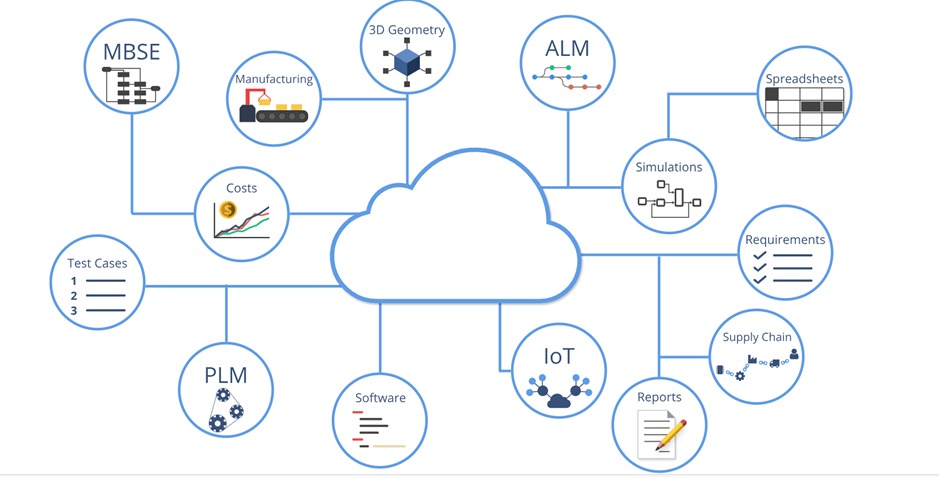The Path to Seamless MBSE: Collaboration Beyond Tools
Conway’s Law states, “Any organization that designs a system will produce a design whose structure is a copy of the organization’s communication structure.” This principle underscores the idea that the systems we create mirror how their creators communicate.
Effective product functionality demands seamless collaboration and compatibility between its components. For this to happen, the authors and designers of each component must ensure constant alignment and so, too, must their tools.

Though the context of the topic was originally software engineering, this principle could be broadly applied to any system that involves collaboration across interdisciplinary systems and teams. As long as there is more than one subsystem and more than one person working on it, effective communication and alignment become critical.
But this discussion isn’t about the differences in human languages or cultural nuances that might influence communication. Instead, it is about the tools engineers rely on, and how the lack of interoperability between them presents a challenge.
Effective collaboration demands seamless alignment, not only among people but also among the tools they use. In the realm of engineering, tools act as the language of communication. However, the lack of interoperability between them presents significant challenges.
But this discussion isn’t about the differences in human languages or cultural nuances that might influence communication. Instead, it is about the tools engineers rely on, and how the lack of interoperability between them presents a challenge.
Across the V-model of systems development, engineers in different phases rely on tools tailored to their specific tasks. Requirements might be managed in Polarion or DOORS, models created in Cameo, and implementation coded in entirely different environments. Each tool exists in a silo, and interoperability is far from straightforward. Importing data from one tool to another often results in errors, data loss, or inefficiencies. This fragmentation undermines the promise of systems engineering as a Single Source of Truth, where all aspects of a system’s lifecycle are seamlessly connected. Ironically, MBSE itself seems to struggle with the very principles it aims to apply.
The vision of Model-Based Systems Engineering (MBSE) is to unify, but the reality remains fragmented. Tool silos, disconnected data, and proprietary extensions exacerbate the problem. While companies often create proprietary formats to differentiate their products, protect intellectual property, and secure market share, their efforts are typically driven by the desire to create their own version of the Single Source of Truth. This pursuit, though well-intentioned, inadvertently deepens the divide and complicates collaboration across disciplines.
Historically, various industries have encountered similar challenges. In software development, efforts like UNIX and open-source platforms aimed to establish universal compatibility, yet proprietary systems persisted. The automotive industry adopted standards like AUTOSAR to harmonize software development, while aerospace relied on frameworks like MIL-STD-1553 to enable interoperability. Despite these efforts, proprietary implementations remained prevalent, driven by competitive differentiation and tailored solutions.
Solving these challenges requires both standardization and innovation. Universal frameworks like SysML, OSLC, and FMI can improve consistency and compatibility, minimizing integration efforts. However, rigid standards may constrain creativity, highlighting the need for a balance between structure and flexibility. Beyond frameworks, open-source collaborative platforms offer a promising path. Such platforms could host libraries and tools designed specifically to bridge gaps between MBSE environments. For instance, a publicly accessible library linking Cameo with Excel could foster a community of shared solutions, reducing dependency on proprietary systems and accelerating development.
While standardization provides a foundation for consistency, open-source collaboration encourages innovation. Together, they represent complementary approaches to addressing the interoperability challenges in MBSE. As we reflect on these solutions, it’s essential to acknowledge that achieving seamless integration is not just a technical challenge but also a cultural one. The engineering community must embrace openness and collaboration to truly realize the vision of a unified systems engineering framework.
This discussion is just the beginning. The future of systems engineering and MBSE depends on collective efforts to bridge divides, foster innovation, and create tools that empower rather than constrain. How can we, as a community, contribute to this vision? The answers lie in our willingness to collaborate, share, and innovate together.
While standardization provides a foundation for consistency, open-source collaboration encourages innovation. Together, they represent complementary approaches to addressing the interoperability challenges in MBSE. As we reflect on these solutions, it’s essential to acknowledge that achieving seamless integration is not just a technical challenge but also a cultural one. The engineering community must embrace openness and collaboration to truly realize the vision of a unified systems engineering framework.
If you are interested in understanding how to adopt systems engineering and model based systems engineering practices within your organization, reach out to BlueKei Solutions team at info@Blue-Kei.com. We specialize in systems engineering consulting, project executions, process adoptions such as compliance to ISO15288, ARP 4754A, ISO 42020, digital transformations. We can also conduct capability development workshops which are experiential and tailored to your needs. With systems engineering adoption you can address the complexity, manage evolving risks and bring transformation in communication within your organization through digitalization and create the digital thread.

